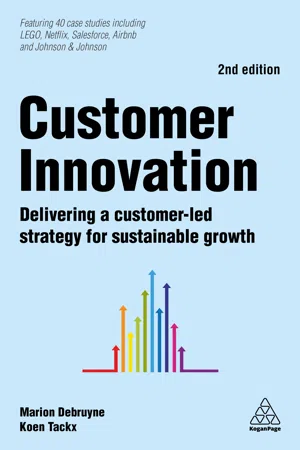
Customer Innovation
Delivering a Customer-Led Strategy for Sustainable Growth
- English
- ePUB (mobile friendly)
- Available on iOS & Android
Customer Innovation
Delivering a Customer-Led Strategy for Sustainable Growth
About this book
WINNER: CMI Management Book of the Year Awards 2015 - Innovation and Entrepreneurship Category (1st edition)Many organizations approach customer-centic marketing and innovating their business strategy in isolation to one another, missing groundbreaking opportunities for advancement. Customer Innovation, second edition, turns this on its head by starting with the customer, innovating around their needs, then building a customer led business strategy around it. It presents a well-constructed three-by-three formula of connect, convert, collaborate, laying the foundations for innovation and change, to improve the current customer journey and expand into new customer horizons. This enables new product and service development to flow with outstanding efficiency and substantial growth. Customer Innovation, second edition, includes exciting updates around co-creation and the benefits of involving customers, stakeholders and employees from the beginning. It provides guidance on using technology to reinvent traditional business models, with consumer needs at the heart. With a spectacular range of case studies, including Disney, LEGO and Johnson & Johnson, all delivered with active takeaways, this is the ultimate handbook for any leader, business or marketing strategist, ready to pave the way in a new era of customer led strategy.
Frequently asked questions
- Essential is ideal for learners and professionals who enjoy exploring a wide range of subjects. Access the Essential Library with 800,000+ trusted titles and best-sellers across business, personal growth, and the humanities. Includes unlimited reading time and Standard Read Aloud voice.
- Complete: Perfect for advanced learners and researchers needing full, unrestricted access. Unlock 1.4M+ books across hundreds of subjects, including academic and specialized titles. The Complete Plan also includes advanced features like Premium Read Aloud and Research Assistant.
Please note we cannot support devices running on iOS 13 and Android 7 or earlier. Learn more about using the app.
Information
PART ONE
The zoom lens
01
Connect using the zoom lens

- Feedback loop from customers. The first practice is about enabling a constant feedback loop from customers into your organization. With this, the company enables a dialogue between customers and the company that allows it to listen to their input on a continuous basis and immediately integrate what is learnt.
- Immersive customer understanding. This is about getting close to customers within their own environment. The strongest insights often do not come from studying survey reports about customers, but from understanding the real-life situations of customers. It is only when we immerse ourselves in our customers that we uncover rich insights that reflect their context: their business, their processes, their life, their behaviours…
- Using all the information you have. Companies often have more information about customers than they realize. The key is to discover all current (and potential) sources of information and unlock their potential. Often, this also means creating new platforms and processes to generate new sources of information.
- Customers as a source of ideas. The best way to make sure that customers have a voice in the company’s strategy and actions is to use their ideas to shape your own. Here, we involve customers in the idea-generating process directly.
- Customers as developers. Customers often create solutions for their problems or adapt products to better suit their needs. In essence, this means that customers take up the role of developers. Smart companies tap into the opportunity to use these ideas and engage customers as developers.
Establish a feedback loop from customers
Table of contents
- Cover
- Title Page
- Copyright
- Contents
- List of Figures
- List of Tables
- List of case studies
- List of HOW TO boxes
- Preface
- Acknowledgements
- Introduction: connect–convert–collaborate: how to build a customer-driven innovation journey
- PART ONE The zoom lens – Laying the foundation for outside-in strategy
- PART TWO The wide lens – How to innovate your current customer journey
- PART THREE The fisheye lens – Expanding your customer base to new horizons
- PART FOUR Conclusion
- Index
- Backcover